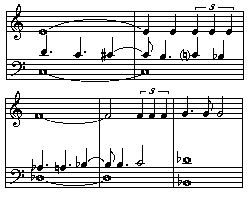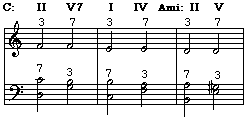
[from JPSL No. 15]
with playable MIDI files
For "classical" music, since the Renaissance, the standard texture has been four-part counterpoint; a melody (the soprano), bass line, and the inner voices alto and tenor. The alto interacts with the soprano in a paired relationship which tends to be subservient; a common example is a melody in parallel 3rds or 6ths, which is an excellent jazz resource to practice. But because the bass is far from all the other voices in register, and has a special harmonic function to fulfill, the tenor is the textural voice that tends to operate most independently. In jazz piano terms, this is often the "thumb line" or line played by the left thumb.
Tonal harmony pivots around the third and seventh of each successive chord. A principle of harmony that's supposed to be learned early on by jazz students is the idea that in circle-of-fifths progressions, the seventh goes to, or becomes, the third, and vice versa:

This simple concept is the real kernel of all harmony. No matter how the chords are extended, altered, substituted or even subverted, this is the underlying dynamic principle. The line that is created is intrinsically composed of repeated notes, half or whole steps; if there are too many leaps, the feeling of a line is lost.
In many progressions, a definite tenor line seems to leap out. Star Eyes is a good example:

As we study chord voicings, we learn how our fingers work in progressions which are incorporating these 7—3—7 movements along with others:

As I've discussed in other contexts, there's a whole gamut of variations on these voicings. Just taking this II—V—I as an example:
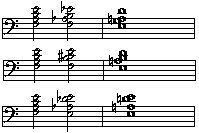
In the last example, notice how the 7—3 in Dmi to G7, has given way to 7 going to #4 (i.e., the C going to C#). The leading tone (the third of G7) is not even present; our ears are so accustomed to it that we can do without it.
Thus, the voicings given by harmony are creating lines, moving inner voices (historically the opposite was the case; moving voices created harmony, a process that took some five hundred years to settle into a codified harmonic system that we now call tonality). It's just a step to allow these voices to move with more independence; specifically, in shorter note values.

The chord names are here given for complete clarity, but they would hardly be written out in a chart. This is the kind of detail that the pianist spontaneously supplies.
The particular sort of line given here, jogging between 7 and #7 of II and 3 of V, is extremely common. A relatively new cliché is to land first on the #7 and go down from there:

A more coherent line results in descending from 8 (i.e., the root):

Standards with slow moving or repeated II—Vs are often interpreted today with a dominant pedal under a figure like these. An obvious example is Body & Soul, with its two-bar II—V an invitation to play:
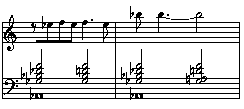
Since we know the original harmony of Body & Soul (don't we?), it becomes clear that harmonically the second chord of this sequence, the one with the raised 7th, is really a form of V of II, i.e. in this case Bb7.
There are a lot of possible four-note descending lines in circle-of-fifths progressions that are well worth focusing on. One is familiar from the Jobim tune Wave:
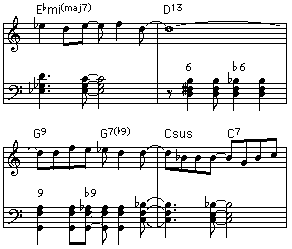
(A fragment of the tune, m. 6-9.) The line (B—Bb—A—Ab) works very well over these secondary dominants. If the D were a minor chord it wouldn't work so well.
Monk's version of April in Paris contains an irresistible descending inner line on the unusual Emaj—G7 progression:
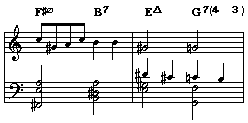
Study these examples carefully. You can find innumerable opportunities for such inner lines in all sorts of situations. Since passing tones are often involved, it's not hard to develop a certain freedom in playing inner voices. A random example might be You Stepped Out of a Dream:
